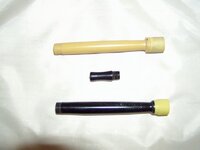These are two unfinished pen bodies I thought I might post to show how I am doing it. Don't know if it is the right way or not and wouldn't mind suggestions if not.
Basically, I drill the blank, cut the threads for the cap and section and then CA a stub of waste material to the closed end, center drill it in the lathe for concentricity, and -if needed because of material strength- have a section piece that I screw into the other end to go against the live center (gonna make a piece for this out of brass or something someday).
These are basically turned with the finishing step being shaping the end down to it's final shape and diameter so it parts off when finished and leaves just a bit of hand finishing on the end to complete it.
I see no reason this shouldn't work for making closed end kit pens as well as kitless, but really haven't tried it to any extent as I'm concentrating on learning kitless at the time.
Anyone else do it this way? Any suggestions?
(My photography is slowly improving but still kind of crummy, they actually look much better in person)
Tube cast 3M fiberglass resin used for these two, one solid color and one with some pearl white pearlex added to give it a sparkle (which actually looks good in person if not in the picture). (And yes, I'm too cheap to buy a mandrel or real blanks.)
Basically, I drill the blank, cut the threads for the cap and section and then CA a stub of waste material to the closed end, center drill it in the lathe for concentricity, and -if needed because of material strength- have a section piece that I screw into the other end to go against the live center (gonna make a piece for this out of brass or something someday).
These are basically turned with the finishing step being shaping the end down to it's final shape and diameter so it parts off when finished and leaves just a bit of hand finishing on the end to complete it.
I see no reason this shouldn't work for making closed end kit pens as well as kitless, but really haven't tried it to any extent as I'm concentrating on learning kitless at the time.
Anyone else do it this way? Any suggestions?
(My photography is slowly improving but still kind of crummy, they actually look much better in person)
Tube cast 3M fiberglass resin used for these two, one solid color and one with some pearl white pearlex added to give it a sparkle (which actually looks good in person if not in the picture). (And yes, I'm too cheap to buy a mandrel or real blanks.)

